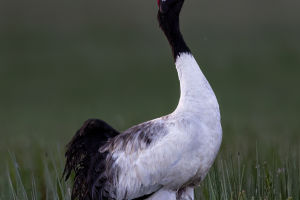The giraffe holds the title of being the tallest land animal in the world and stands as an iconic species of the African savannah. Known for its distinctive long neck and dappled markings, the giraffe is truly a remarkable creature.
Giraffes can reach staggering heights of up to 4.8 meters, with males generally surpassing females in height. Their necks can extend up to 2.5 meters and are comprised of 7 cervical vertebrae, just like the cervical vertebrae found in humans. This remarkable adaptation enables giraffes to effortlessly browse high leaves and twigs.
With their protruding eyes and long eyelashes, giraffes possess natural defenses against the sun and tree branches. Additionally, they possess sturdy legs and feet with two toes on each foot. The skin of a giraffe showcases a distinct pattern that is unique to each individual, similar to a human fingerprint.
Giraffes primarily inhabit African savannahs, open woodlands, and shrubbery. They feed on a diverse array of vegetation, including leaves, twigs, fruits, and nuts. Giraffes boast a powerful digestive system that efficiently breaks down these fibrous plant materials.
These magnificent creatures typically reside in groups, with each group consisting of several adult females, their young, and a few males. Giraffes are known for their peaceful and gentle nature, utilizing their long and powerful legs to reach speeds of up to 60 kilometers per hour when evading predators.
As one of Africa's iconic symbols, the giraffe plays a vital role in maintaining the ecosystem. Sadly, they face numerous threats such as habitat loss, hunting, and illegal trade. Safeguarding giraffes and their habitats is crucial for upholding biodiversity and ecological balance.
The distinctive appearance and graceful demeanor of giraffes make them subjects of fascination and study. Their presence not only evokes awe for the wonders of nature but also inspires a sense of responsibility for animal conservation and environmental protection.
As a protected species, giraffes encounter several challenges in conservation efforts. Here are several crucial steps that must be taken to protect giraffes:
Habitat Conservation: Preserving adequate living space for giraffes is paramount. This entails safeguarding suitable habitats such as savannahs, woodlands, and scrublands while preventing habitat destruction and fragmentation.
Combating Illegal Trade: Tackling the issue of illegal giraffe trade, which includes hunting and smuggling. Strengthening law enforcement is crucial to combat illegal giraffe killings while reinforcing border controls can deter the illegal trade of giraffes and their products.
Education and Awareness: Enhancing public education and awareness campaigns focused on giraffe conservation. By raising awareness regarding the importance and endangered status of giraffes, communities can be mobilized to take action through educational programs and engagement.
Scientific Research: Conduct scientific research on giraffe ecology, behavior, and population dynamics. These studies aid in understanding giraffes' needs and vulnerabilities, facilitating the development of effective conservation strategies.
International Cooperation: Fostering international collaboration to collectively protect giraffes. Collaborative efforts and information exchange between countries can stimulate global action for giraffe conservation, including the establishment and management of transboundary protected areas.
Engagement of Non-Governmental Organizations: Encouraging participation from non-governmental organizations and communities in giraffe protection endeavors. These organizations can contribute funding, expertise, and community mobilization support to advance giraffe conservation.
Climate Change Adaptation: Addressing the impact of climate change on giraffe habitats. Climate-related challenges such as drought, grassland degradation, and food shortages can significantly affect giraffes' survival. Implementing adaptation measures ensures their ability to cope with changing environmental conditions.
The preservation of giraffes requires not only the commitment of governments and international organizations but also the active participation and support of the general public. Only through collaborative and concerted efforts can we effectively safeguard giraffes, enabling them to thrive and persist on Earth.


